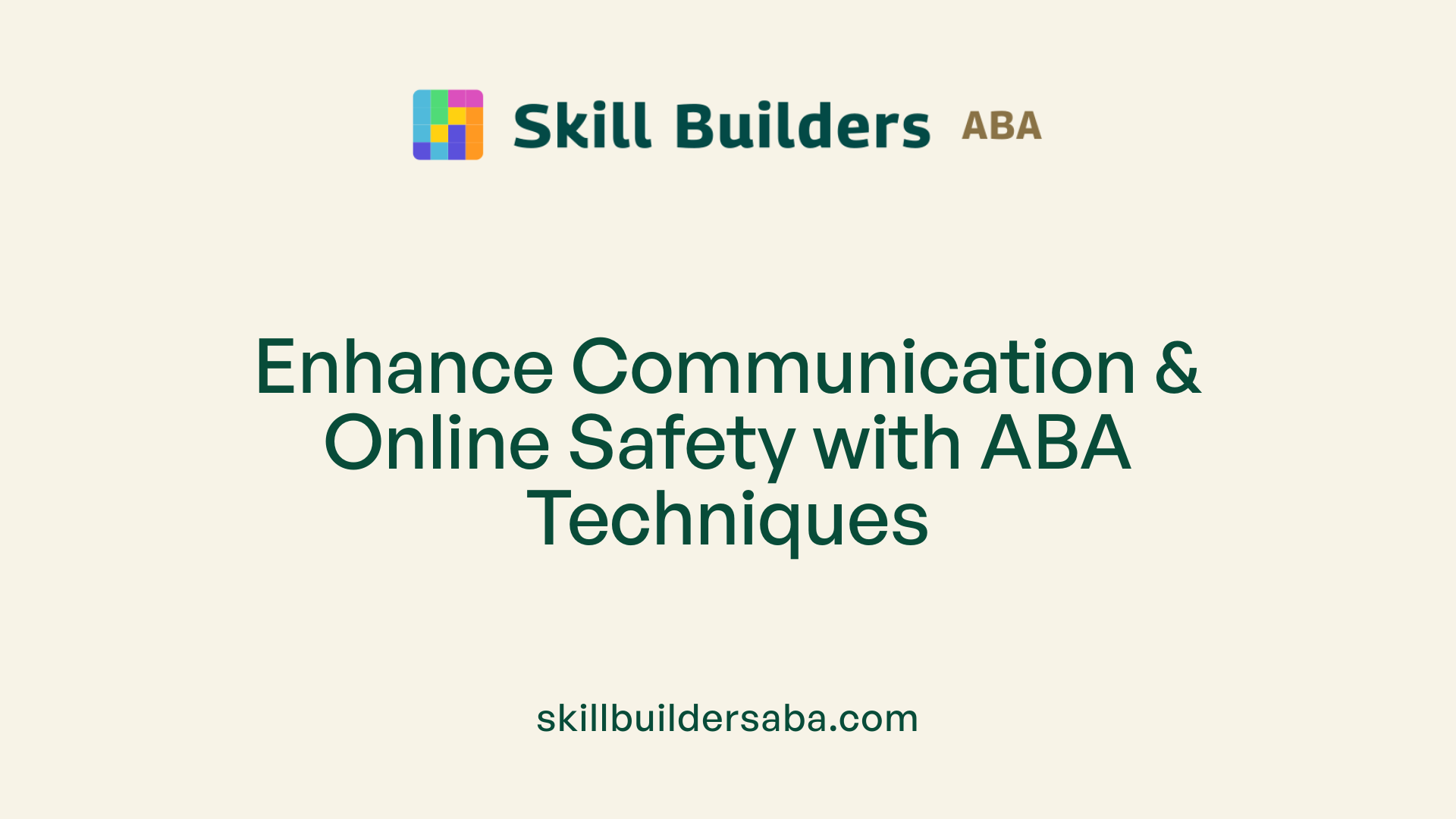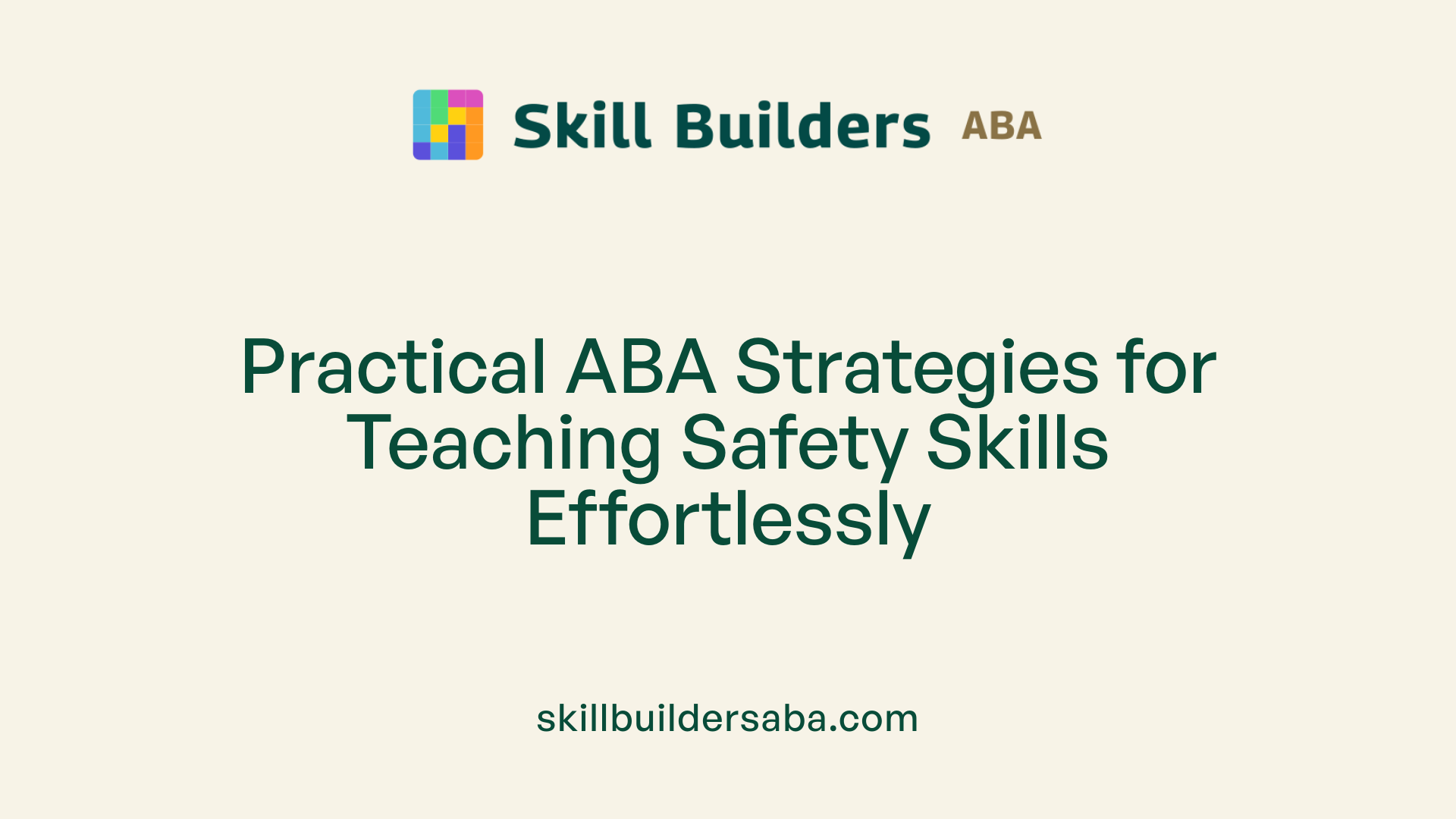
ABA for teaching phone and communication safety
Empowering Safety Through ABA-Based Communication Strategies
Building Foundations in Communication and Safety for Children with Autism
Applying Applied Behavior Analysis (ABA) techniques offers a structured, evidence-based approach to teaching children with autism vital communication and safety skills. This article explores how ABA principles can be effectively utilized to foster safer phone and communication behaviors, emphasizing the importance of individualized, systematic interventions that promote independence and resilience in various settings, including the online world.
Fundamental Principles of ABA for Teaching Communication Safety

What are the fundamental principles of ABA for teaching communication safety?
Applied Behavior Analysis (ABA) offers a structured, scientific approach to teaching communication skills, especially critical for children with autism to navigate safety and social interactions effectively.
A core aspect of ABA involves conducting functional assessments to understand the environmental factors maintaining problematic or unsafe behaviors. This process helps identify why a behavior occurs, whether due to seeking attention, escape, sensory input, or access to tangible items.
Based on assessment findings, therapists select communication responses that are socially valid and serve the same purpose as the problematic behaviors. These are often less effortful, more recognizable, and easier for the individual to use in real-world situations.
Functional Communication Training (FCT) is a key intervention, teaching individuals alternative ways to express their needs and safety concerns. This training employs prompting strategies—such as physical, verbal, or gestural cues—and systematically fades these prompts over time to foster independence.
Reinforcement plays a critical role, where appropriate communication responses are consistently rewarded to increase their frequency. For example, praising a child for using a safe word to indicate discomfort or danger encourages continued use. Conversely, extinction involves withholding reinforcement for unsafe or harmful behaviors, helping to reduce their occurrence.
Ensuring that newly learned skills generalize across different environments and caregivers is vital. Strategies include training multiple teachers or caregivers, using varied environments during instruction, and incorporating natural cues.
Throughout this process, careful data collection and ongoing analysis support the effectiveness of interventions. Adjustments are made based on progress, ensuring that techniques remain ethical, individualized, and aligned with the principles of ABA.
This comprehensive application of ABA principles fosters not only safety but also independence and confidence in social and communication skills essential for navigating everyday life safely and responsibly.
Leveraging ABA to Develop Communication and Online Safety Skills

How can ABA be used to develop communication and online safety skills in children with autism?
Applied Behavior Analysis (ABA) offers effective methods for teaching both communication and online safety skills in children with autism. One of the main techniques involves structured teaching strategies like Discrete Trial Training (DTT), Natural Environment Teaching (NET), and Functional Communication Training (FCT). These methods emphasize breaking down complex skills into manageable steps, promoting better understanding and spontaneous use.
To support children who are non-verbal or have communication barriers, ABA incorporates augmentative and alternative communication (AAC) systems such as PECS (Picture Exchange Communication System) and speech-generating devices. These tools enable children to express their needs and better comprehend social cues.
Verbal Behavior Therapy (VBT), a component of ABA, is focused on building functional language skills. It deals with teaching children to produce and understand critical language operants like mands (requests) and tacts (labels), which are essential for effective social interactions both offline and online.
When it comes to online safety, ABA programs integrate scenario-based practice and social skills training. These activities teach children to recognize potentially dangerous or uncomfortable situations, set appropriate boundaries, and seek help from trusted adults.
To help children apply what they learn, parents and caregivers are encouraged to use reinforcement strategies, prompting, and modeling. These techniques reinforce safety and communication skills across various contexts, including online environments, promoting consistency and competence in real-world situations.
Altogether, ABA offers a comprehensive framework for fostering essential communication and safety skills, contributing to increased independence and confidence for children with autism.
Implementing ABA Strategies for Safety Skills Education

How can ABA be used to teach safety skills such as online safety and community safety?
Applying Applied Behavior Analysis (ABA) to safety education involves a series of structured strategies designed to teach complex skills effectively. One foundational approach is breaking down safety skills into small, manageable steps. For example, learning how to recognize scams online or knowing when to seek help in the community can be simplified into specific, teachable actions.
Visual supports play a crucial role in this process. Using pictures, social stories, and visual checklists can enhance understanding, especially for individuals with communication barriers or sensory sensitivities. These supports make abstract concepts concrete and accessible.
Behavior Skills Training (BST) is a widely used ABA method in safety instruction. It combines prompting, modeling, rehearsal, and reinforcement to teach desired behaviors. During training sessions, learners observe correct behaviors modeled by instructors, practice the skills through role-playing, and receive positive feedback to strengthen their recall and motivation.
In-situ training is another valuable technique. It involves practicing safety skills in real-world settings—such as navigating a neighborhood or online environment—ensuring that learned skills transfer from the teaching environment to everyday situations.
Errorless teaching methods, such as those used in Safety-Care programs, help prevent mistakes that could compromise safety during instruction. These techniques maximize learning efficiency while minimizing risk.
Continuous assessment and tracking of progress are essential to ensure mastery of safety skills. Regular evaluations inform adjustments in teaching approaches and help set achievable goals.
Building related skills like self-awareness, assertiveness, and problem-solving further enhances safety education. These competencies empower individuals to recognize unsafe situations, advocate for themselves, and resolve issues proactively.
By integrating these ABA strategies—breaking down skills, visual supports, BST, real-world practice, errorless teaching, ongoing assessment, and related skill development—educators can foster safer, more confident individuals capable of navigating both online and community environments effectively.
Educational Resources and Interventions Employing ABA for Safety

Are there educational resources or interventions that employ ABA for safety skill development?
Yes, numerous educational tools and programs incorporate Applied Behavior Analysis (ABA) principles to enhance safety skills, especially for individuals with autism or similar needs. One notable example is the Safety-Care® program, which uses structured, errorless teaching approaches to prevent dangerous behaviors and teach safety routines effectively.
Safety teaching with ABA often involves methods such as prompting, reinforcement, and task analysis. These strategies help individuals learn to recognize safety cues, ask for help, and identify trusted helpers or safety personnel. Visual supports like checklists, flowcharts, and social stories are frequently used to improve understanding and recall of safety procedures.
Role-playing and simulated scenarios serve as practical training tools, enabling learners to practice safety skills in controlled environments. This approach supports real-world application and generalization of skills.
Organizations such as Autism Speaks have developed dedicated safety toolkits that provide families, educators, and caregivers with resources such as safety guidelines, checklists, and comprehensive plans tailored to individual needs. These resources emphasize the importance of personalized safety strategies and promote independence while ensuring safety.
Overall, ABA-based safety interventions are grounded in evidence-based techniques that focus on teaching, reinforcing, and maintaining critical safety behaviors. They aim to foster dignity, independence, and well-being for individuals with autism by ensuring they can navigate their environments safely and confidently.
How ABA Enhances Communication and Safety Awareness
How does ABA therapy help improve communication and safety awareness in children with autism?
Applied Behavior Analysis (ABA) therapy plays a crucial role in helping children with autism develop better communication and safety skills. Through structured methods like Discrete Trial Training (DTT), Natural Environment Teaching (NET), and the use of Augmentative and Alternative Communication (AAC) devices, ABA teaches children how to express their needs and desires clearly. This targeted approach ensures that children are better equipped to interact socially and seek help when needed.
In addition to fostering communication skills, ABA incorporates safety education into its programs. Techniques such as role-playing, social stories, and visual supports are used to teach children about personal safety, recognizing hazards, and emergency procedures. These activities help children understand how to respond in various situations, reducing potential dangers.
Positive reinforcement is essential in ABA, encouraging children to practice and retain safety and communication skills. Whether it’s rewarding proper social interactions or safety behaviors, this motivation helps cement these habits. Furthermore, ABA emphasizes the importance of generalizing skills across different environments and with different people. This ensures that children apply what they learn in real life, boosting their independence and confidence.
Overall, ABA’s individualized, evidence-based strategies significantly enhance a child's ability to communicate effectively and stay safe. By providing systematic support tailored to each child’s needs, ABA empowers them to navigate daily life with greater independence and self-assurance, paving the way for a more inclusive, safe future.
Best Practices for Teachers and Therapists in ABA Safety Programs
How can ABA strategies be applied to community and online safety education?
Applying ABA principles to safety education involves creating personalized intervention plans that are grounded in solid data and tailored to each individual's needs. Techniques such as reinforcement, modeling, prompting, and chaining are central to teaching safety skills like recognizing strangers, establishing boundaries, responding to emergencies, and staying safe online.
Teachers and therapists use real-life scenarios to promote learning. For example, role-playing exercises can help children practice identifying safe versus unsafe situations. Visual supports, such as checklists or social stories, provide clear cues that reinforce understanding of safety concepts.
To enhance learning, multimodal approaches are employed. Visual aids, auditory prompts, and hands-on activities ensure that safety concepts stick in various contexts. Resources like the NetSmartz Workshop and online safety toolkits are valuable additions, teaching children about cyberbullying, scams, and responsible internet use.
Involving caregivers and family members is crucial. Training and safety planning at home support the generalization of skills outside structured therapy sessions. Families can practice safety routines, review visual supports, and reinforce safety rules consistently.
In summary, applying ABA in community and online safety education emphasizes repetitive, engaging activities that develop resilience and critical thinking. Building safety awareness through individualization and family involvement ensures children learn to navigate real-world and digital environments confidently.
Fostering Safer Interactions Through Evidence-Based ABA Approaches
Applying ABA principles thoughtfully and systematically offers children with autism practical skills to navigate communication and safety challenges confidently. From developing effective social communication to recognizing online threats, ABA-based interventions nurture independence, safety awareness, and resilience. When tailored to individual needs and reinforced across environments, these strategies not only help prevent unsafe situations but also empower children to advocate for themselves and thrive in diverse settings. As technology continues to evolve, integrating ABA with innovative resources and collaborative efforts will be key to ensuring safer, more inclusive communities for all.
References
- Strategies For Enhancing Safety For Autistic Children
- Internet Safety Skills Program - ABA Behavioral Consulting
- Be Internet Awesome - A Program to Teach Kids Online Safety
- How to Teach Social Skills Using ABA Principles
- ABA Intervention for Autism: Prepare Your Kids For School
- Safety-Care Crisis Prevention Training for PBIS & ABA Environments
- A Survey of Safety Skills Training Used by Behavior Analysts in ...
- Safety skills - Applied Behavioural Interventions
- Teaching Safety Skills to Children: A Discussion of Critical Features ...
- Health and Safety Skills in ABA Therapy | Childwise
Reach Out Today
Learn more about how we can support your child’s growth and development. Contact us to discuss our services and availability in your area.
.svg)